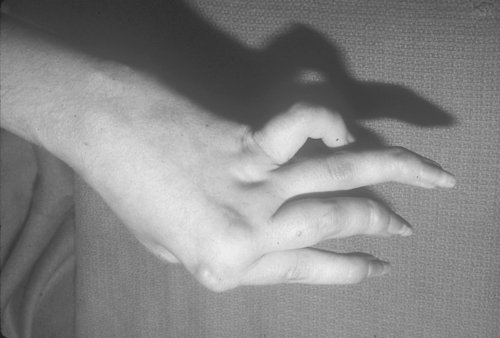CHAPTER 34
Hand Rheumatoid Arthritis
Definition
Rheumatoid arthritis is a systemic inflammatory disorder of unknown etiology. It is a progressive condition that results in deformity and dysfunction when synovial inflammation erodes cartilage, bone, and soft tissues. However, the widespread early use of methotrexate has transformed rheumatoid arthritis into a much less devastating disease [1]. The availability of targeted biologic therapies, such as the tumor necrosis factor (TNF) antagonists, has further improved the outcome of rheumatoid arthritis [2]. Surgery has become much less common and more straightforward in patients with rheumatoid arthritis. For a detailed discussion of rheumatoid arthritis, see Chapter 151.
Symptoms
Presenting symptoms in the hand include joint pain in the fingers as well as stiffness and swelling, typically involving the proximal interphalangeal and metacarpophalangeal joints but—in contrast to osteoarthritis—sparing the distal interphalangeal joints. Stiffness usually is most pronounced in the morning. If it is left untreated, rheumatoid arthritis may result in progressive deformity and disability.
Physical Examination
The evaluation of a rheumatoid arthritic hand should include the following: joint pain and inflammation; joint stability; limitations in active and passive range of motion for grip and pinch strength deficits; limitations in hand dexterity; and degree of disability with respect to self-care, vocational activities, and recreational activities.
Early in the course of disease, involved joints are usually stiff, painful, and swollen as synovitis predominates. In some patients, the first sign of rheumatoid arthritis may be extensor tenosynovitis on the dorsum of the hand and wrist (although this can also be an idiopathic condition). Chronic synovitis may destroy capsuloligamentous and tendinous structures, creating laxity and deformity. In rheumatoid arthritis, in contrast to the arthritis of systemic lupus erythematosus, this soft tissue damage is usually accompanied by destruction of bone with periarticular erosions evident on radiographs.
Typical hand deformities associated with advanced rheumatoid arthritis include boutonnière deformity (flexion deformity of the proximal interphalangeal joint and extension deformity of the distal interphalangeal joint) and swan-neck deformity (hyperextension of the proximal interphalangeal joint with flexion of the distal interphalangeal joint). It is not uncommon to see varying patterns on the fingers of one hand (Fig. 34.1).

Inability to extend the index through small fingers may be due to the following: deformity and subluxation or dislocation of the index through small finger metacarpophalangeal joints; ulnar translocation of the extensor tendons due to laxity and destruction of the radial sagittal bands; extensor tendon ruptures due to a combination of dorsal tenosynovitis and distal radioulnar joint deformity or abrasions; or posterior interosseous nerve compression by elbow synovitis. Ulnar drift of the fingers usually accompanies each of these deformities.
Rupture of the extensor tendons usually proceeds in a sequence from ulnar to radial, referred to as the Vaughn-Jackson syndrome [3]. Mannerfelt syndrome is the equivalent on the volar side, progressing from the thumb to the index and long fingers, producing tendon ruptures as a result of synovitis and scaphotrapezial trapezoid irregularity [4].
Synovitis in the wrist results in volar and ulnarward subluxation and supination of the hand in relation to the forearm. This wrist deformity can exacerbate the Vaughn-Jackson syndrome and ulnar drift.
Extensive synovitis or tenosynovitis can cause nerve compression, but, except for carpal tunnel syndrome, this is uncommon now that synovitis is controlled by effective medications.
Functional Limitations
Surgery is considered when correction of a deformity will improve function. Rheumatoid deformities typically progress slowly, and patients often adapt well. In some cases, realignment or stabilization of one joint or finger will actually decrease function because it will interfere with an adaptive mechanism. For this reason, surgery for rheumatoid deformity must carefully match the functional desires and goals of the patient with the risks and benefits of operative intervention. Many severe deformities are left untreated when patients have adapted well.
Diagnostic Studies
The diagnosis of rheumatoid arthritis is based predominantly on its clinical presentation. Laboratory testing is used to monitor disease activity and toxicity of drug therapy. Acute phase reactants, such as C-reactive protein and erythrocyte sedimentation rate, may be elevated in the setting of active joint inflammation. Most patients with rheumatoid arthritis have circulating rheumatoid factor or anti-citrullinated protein antibodies. The presence of one of these serologic markers suggests a more aggressive and destructive disease course.
Diffuse periarticular osteopenia is the earliest radiographic sign of rheumatoid arthritis. Joint space narrowing and periarticular erosions may be observed in more than half of patients with rheumatoid arthritis during the first 2 years of disease [5]. If left untreated, joints involved by rheumatoid arthritis may be destroyed by chronic synovitis.
Diagnostic ultrasonography is often used to detect early erosions and joint swelling in patients with rheumatoid arthritis [6]. Magnetic resonance imaging of the hand may reveal synovitis and erosions early in the course of rheumatoid arthritis. However, radiographs remain the reference standard for diagnostic imaging of rheumatoid arthritis.
Treatment
Initial
Nonsteroidal anti-inflammatory drugs decrease pain and inflammation by inhibiting prostaglandin synthesis; they do not inhibit synovial proliferation and thus do not slow the progression of bone erosion and joint destruction. Low-dose corticosteroids also reduce symptoms of joint inflammation; but unlike nonsteroidal anti-inflammatory drugs, low-dose corticosteroids retard the progression of joint destruction. However, the widespread use of corticosteroids is limited by their many deleterious side effects, including osteoporosis, osteonecrosis of bone, cataracts, cushingoid features, and hyperglycemia.
Since the mid-1980s, the widespread and early use of low-dose weekly methotrexate has transformed rheumatoid arthritis into a much less destructive disease than it had been previously. Leflunomide also may be used to suppress synovial proliferation and joint destruction [7







